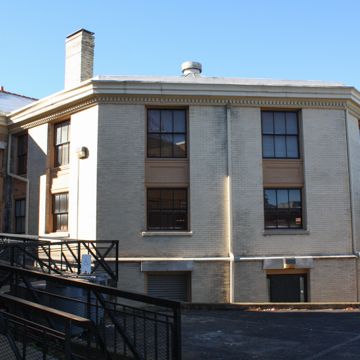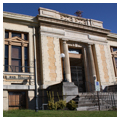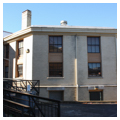You are here
Carnegie Center for Arts and History
The Jackson Free Library is the first of twenty purpose-built libraries funded by Andrew Carnegie in Tennessee. At the turn-of-the-twentieth century, the mantra of southern progressives dedicated to civic reform was that good roads, good schools, and good libraries would build a better New South. The Carnegie libraries were more than book repositories—they were civic centers where residents of all classes could be enlightened, educated, or entertained. Built in 1901–1903, this impressive Beaux-Arts library contained 25,000 books, community meeting rooms, a children’s library, a museum, and a place to read newspapers and magazines. The Jackson Free Library continues to serve that purpose as a public center for arts and history.
Located in downtown Jackson in West Tennessee, the Jackson Free Library was built two blocks northeast of the county courthouse square. The town, named for Andrew Jackson when it was founded as the seat of Madison County in 1821, opened its first subscription reading room in the 1830s. By 1886, this institution had evolved into the Jackson Free Library Association with a mission of opening a free public library. In 1900 local community leaders requested that the city provide $75,000 to match a potential Carnegie library grant. The city council denied the request but agreed to purchase a parcel of land and to provide annual maintenance funds, which satisfied Carnegie’s library grant requirements. In 1901 the city received a $30,000 library grant from Carnegie, the first in Tennessee.
The city hired Nashville architect Anthony “A” Ten Eyck Brown to design the library. A native of Albany, New York, and son of an architect, Brown studied at the New York Academy of Design. He had previously worked for J. Edwin R. Carpenter, in the New York architect’s affiliate office in Nashville. Brown relocated to Atlanta and designed many prominent residential, commercial, and civic buildings throughout the Southeast. Parish Brothers Construction Company, based in Jackson built the library to Brown’s design.
Tennessee Governor Benton McMillan attended the grand cornerstone laying ceremony on September 11, 1901 and the library opened to the public on March 3, 1903. The tan and buff pressed-brick building, trimmed in limestone and capped with a red clay tile roof, is a good example of a Beaux-Arts civic building. The library has a projecting entrance portico supported by Doric columns. The recessed portico exhibits limestone pilasters and alcoves with marble steps and a coffered ceiling. The limestone cornerstone is inscribed, “Jackson Free Library A.D. 1901.” The exterior exhibits decorative elements such as corner quoins, pediments, keystones, a roof-mounted balustrade, tripartite windows, and molded trim.
At the rear of the building is a two-story, five-sided wing that originally featured radiating book stacks and a central circulating desk. This domed room is lit by an octagon-shaped, roof-mounted skylight, and exhibits glass blocks in the floor to filter light to the basement community meeting rooms. No other Carnegie library in Tennessee had such a rotunda-style stack room, but they were common in northern cities such as the neighborhood branches in Pittsburgh.
The interior of the two-story building is trimmed lavishly with wooden bookcases, tile floors with mosaic patterns, and an ornate, curved stair leading to an upper-level balcony. Made of wrought iron with marble steps, this balcony overlooks what was once a large stack room. Substantial reading rooms, one for adults and one for children, flank the center entrance hall.
In 1900, Jackson had over 36,000 residents, 46 percent of whom were black. But due to the state’s Jim Crow laws, the Jackson Free Library was open only to white residents. The city’s nearly 17,000 black residents received checkout privileges, but were not allowed to stay in the library to read. This was unusual, since in the South the vast majority of cities prohibited the use of public libraries by blacks in any manner. Large cities offered separate branch libraries for black residents and small towns sometimes operated makeshift branch libraries in black high schools. During Booker T. Washington’s tour of Tennessee in 1909, he visited the Jackson Free Library and later wrote to Andrew Carnegie about the unique arrangement that allowed black residents limited use of the whites-only public library.
Since Jackson had no City Hall at that time, the Jackson Free Library also served as an important meeting and assembly place for community groups, such as the Confederate veterans, women’s clubs, and historical societies. In the 1910s, the children’s reading room was converted into a local museum, exhibiting an impressive collection of geological specimens, fish, birds, and Indian pottery donated by the Smithsonian Institute in Washington, D.C.
After Jackson built a new library in 1968, the Carnegie building stood vacant for many years. In the 1980s, the Tennessee Historical Commission provided funding and planning for the building’s rehabilitation into a multicultural arts and history center. Reopening in 1988 as the Carnegie Center for Arts and History, the building is used for cultural events, musical performances, art exhibits, and a local history museum. In 2003 a deadly F4 tornado leveled several nearby buildings but the library was undamaged.
References
Bradley, Lee W., “Jackson Carnegie Free Library,” Madison County, Tennessee. National Register of Historic Places Inventory-Nomination Form, 1975. National Park Service, U.S. Department of the Interior, Washington, D.C.
Craig, Robert M. “A. Ten Eyck Brown (1878-1940).” New Georgia Encyclopedia, 2013. Accessed January 10, 2015. http://www.georgiaencyclopedia.org/articles/arts-culture/ten-eyck-brown-1878-1940.
Herndon, Joseph L. “Architects in Tennessee until 1930: A Dictionary.” Master’s thesis, Columbia University, New York, 1975.
Jones, Robbie D. “What’s In A Name? Tennessee’s Carnegie Libraries & Civic Reform in the New South, 1889-1919.” Master’s thesis, Middle Tennessee State University, 2002.
Van Slyck, Abigail A. Free To All: Carnegie Libraries and American Culture, 1890–1920. Chicago: University of Chicago Press, 1995.
Writing Credits
If SAH Archipedia has been useful to you, please consider supporting it.
SAH Archipedia tells the story of the United States through its buildings, landscapes, and cities. This freely available resource empowers the public with authoritative knowledge that deepens their understanding and appreciation of the built environment. But the Society of Architectural Historians, which created SAH Archipedia with University of Virginia Press, needs your support to maintain the high-caliber research, writing, photography, cartography, editing, design, and programming that make SAH Archipedia a trusted online resource available to all who value the history of place, heritage tourism, and learning.

























